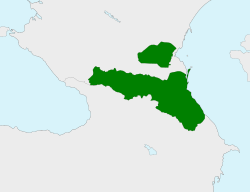Mountainous Republic of the Northern Caucasus | |||||||||
|---|---|---|---|---|---|---|---|---|---|
| 1917 [1] –1919 [2] | |||||||||
 Mountainous Republic of the Northern Caucasus | |||||||||
| Capital | Temir-Khan-Shura | ||||||||
| Common languages | Chechen Ingush Lezgian Avar Ossetic Kabardian Karachay-Balkar Kumyk Abaza Dargwa Nogai Tabasaran Abkhaz [7] Various other North Caucasian languages Russian (official language) (lingua franca) [8] | ||||||||
| Religion | Sunni Islam (majority and official state religion) Russian Orthodox Church (minority) | ||||||||
| Demonym | North Caucasian | ||||||||
| Government | Confederated parliamentary republic under a provisional government | ||||||||
| Prime Minister | |||||||||
• 11 May 1918 – December 1918 | Tapa Tchermoeff | ||||||||
• December 1918 – 12 May 1919 | Pshemakho Kotsev | ||||||||
| Establishment | |||||||||
| History | |||||||||
| 6 March 1917 | |||||||||
• Independence declared | 11 May 1918 | ||||||||
| September 1919 | |||||||||
• Established | 1917 [11] | ||||||||
• Disestablished | 1919 [2] | ||||||||
| Area | |||||||||
• Total | 430,874 km2 (166,361 sq mi) | ||||||||
| Population | |||||||||
• 1919 census | 4,221,860 [8] | ||||||||
| Currency | Tumen | ||||||||
| |||||||||
| Today part of | Russia Azerbaijan Georgia | ||||||||
The Mountainous Republic of the Northern Caucasus (MRNC), also referred to as the United Republics of the North Caucasus, Mountain Republic, [a] or the Republic of the Mountaineers, was a short-lived state in Eastern Europe. It encompassed the eastern portion of the North Caucasus and emerged during the Russian Civil War and existed from 1918 to 1919. It formed as a consolidation of various North Caucasian ethnic groups, including the Abazins, Circassians, Chechens, Karachays, Ossetians, Balkars, Ingush, and Dagestanis.
Contents
- State formation
- History
- Legacy
- Prominent government figures, 1917–1919
- See also
- Notes
- References
- Bibliography
The MRNC encompassed the former territories of Terek Oblast and Dagestan Oblast within the Russian Empire. These territories now constitute the present-day republics of Chechnya, Ingushetia, North Ossetia–Alania, Kabardino-Balkaria, Dagestan, and a portion of Stavropol Krai in the Russian Federation. Spanning approximately 430,874 square kilometers (166,361 sq mi), the MRNC had a population of approximately 11.2 million. Throughout its existence, the capital of the MRNC relocated from Vladikavkaz to Nazran and ultimately settled in Temir-Khan-Shura.
The MRNC broke away from the Russian Empire after the February Revolution, just before the outbreak of the Russian Civil War. The Russian Volunteer Army captured the state in 1919, and it ceased to exist. [2] However, in September 1919, the North Caucasian Emirate was proclaimed as the successor of the Mountain Republic. [10] However, in August 1920, it was captured by Soviet Russia, which led to an uprising. [12] In April 1921, the Mountain Autonomous Soviet Socialist Republic was established by the Bolsheviks within the RSFSR, but the uprising lasted until 1925. [13]













